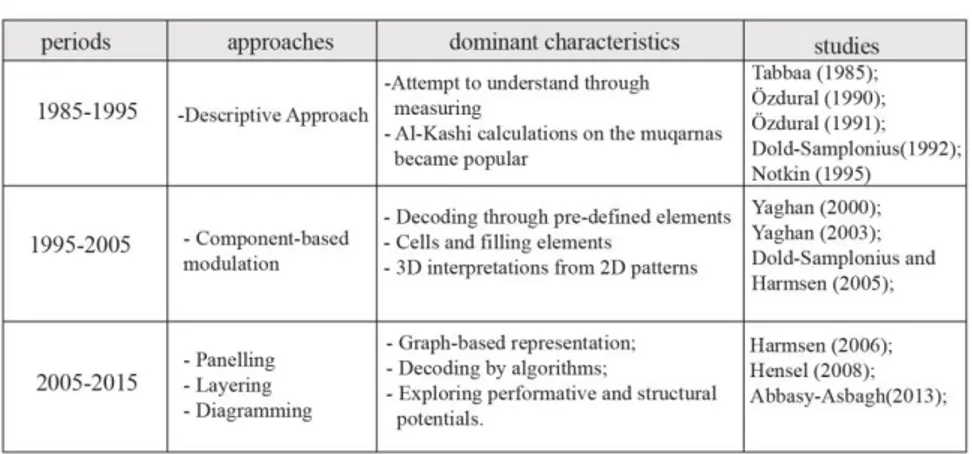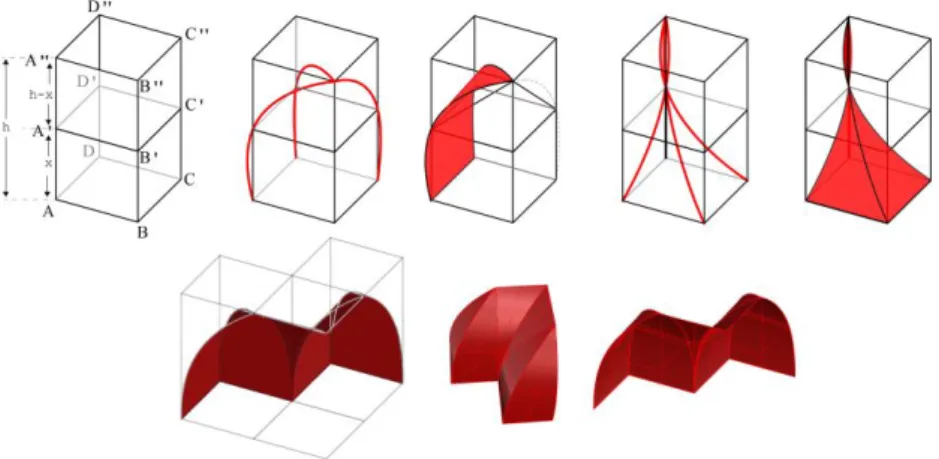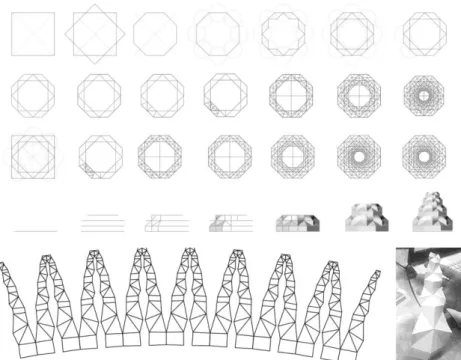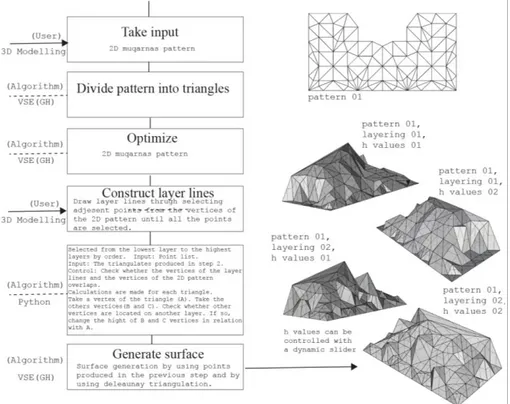See discussions, stats, and author profiles for this publication at: https://www.researchgate.net/publication/310374670
COMPUTATIONAL INTERPRETATIONS OF 2D MUQARNAS PROJECTIONS IN 3D
FORM FINDING
Conference Paper · January 2016
CITATIONS
0
READS
1,510 2 authors:
Some of the authors of this publication are also working on these related projects:
“Analysis of the Effects of Haptic and Body-Spatial Perception During Architectural Modelling Process” (Istanbul Technical University Rectorate, Scientific Research Project Foundation, No: 34547)View project
Muqarnas StudiesView project Sema Alaçam
Istanbul Technical University 39PUBLICATIONS 19CITATIONS
SEE PROFILE
Orkan Zeynel Güzelci T.C. Istanbul Kultur University 17PUBLICATIONS 5CITATIONS
SEE PROFILE
All content following this page was uploaded by Orkan Zeynel Güzelci on 16 November 2016.
COMPUTATIONAL INTERPRETATIONS OF 2D MUQARNAS PROJECTIONS IN 3D FORM FINDING
S.ALAÇAM, O. Z. GÜZELCİ
Istanbul Technical University, Istanbul Email address: semosphere@gmail.com Istanbul Kultur University, Istanbul Email address: orkanguzelci@gmail.com
Abstract. In the scope of this study, we developed an algorithm to generate new 3D geometry (interpretation) of a given or generated planar projection of a muqarnas in a digital 3D modelling software (Rhinoceros), its visual scripting environment (VSE) Grasshopper and also Python programming language. Different than the traditional methods, asymmetrical form alternatives are examined. In other words, 2D projections of muqarnas were only used as an initial geometrical pattern for generative form finding explorations. This study can be considered as an attempt to explore new relations, rules and vocabulary through algorithmic form finding experiments derived from 2D muqarnas projections.
1. Introduction
As an architectural element, it is possible to come across Muqarnas in a wide geographical zone from Spain to India. There are different opinions about the origin and development of it, tracing back 4th or 10th century (Dold-Samplonius, 1992). One of the earliest, major and written resources on muqarnas is Al-Kashi’s “Key of Arithmetics” book, which covers arithmetic and geometric definitions of muqarnas construction for artisans/master masons (Al-Kashi, 1427/1977). Harb’s (1978) study provided another basic foundation for researchers in this field. The focus of the related studies increased from early 1990s can be read in three decade-based directions: 1990s as descriptive and typology based approaches, 2000s as geometrical decoding and 2010s as exploratory computational studies.
The common denominator of most of the studies on muqarnas is its decorative potential. A few recent studies examined the structural, functional and performative potentials (Hensel, 2008; Abbasy-Asbagh,
2 S.ALAÇAM AND O. Z. GÜZELCİ
2013) and algorithmic reconstructions (Yagdan, 2000; Harmsen, 2006) of muqarnas. Another common tendency in muqarnas studies is using pre-redefined typology and definitions. However, 3D muqarnas formation might provide new insights to the mathematical understanding of form beyond its aesthetic and ornamental qualities in the digital age. In other words, muqarnas formation has potentials to be decoded by a series of rules, algorithms or topological relations instead of only considering the pre-defined components.
In the traditional construction practice, artisans/master masons have been gaining the knowledge of doing by constructing on site or from definitions in manuscripts. There were constraints derived from the material selections, construction methods and building on site. The 2D patterns were designed firstly and then used as a base for 3D constructions. A collection of these 2D drawings can be found in Notkin (1995)’s study. Dold-Samplonius (1992) also mentions the usage of predefined elements and their assembly. These constraints and reasons might have been affected the emergence of limited amount of novelty in muqarnas formations. We are aware but in the scope of this paper we neglect the material usage and the technique in historical muqarnas construction.
2. Related Studies on Muqarnas
It is not possible to approach to studies on muqarnas in separated periods with concrete properties. Keeping this in mind, in order to gain a comprehensive understanding, our goal is to investigate the related studies in three decade-based thresholds. Those thresholds are Description (1985-1995), Decodification (1995-2005) and Interpretation (2005-2015). A property, method or approach that we introduce might be seen in all three thresholds; however, we made assumption based on the distinction of the characteristics.
In the first period in which manuscripts of Al-Kashi and his calculations have been studied (Özdural, 1990; Özdural ,1991). Those calculations and definitions constituted a basis for the further studies (Harmsen, 2006). Some 2D (Figure 1A) and 3D (Figure 1B) geometric relations by Al-Kashi were introduced by Özdural (1990). Those typological definitions are helpful for explaining the production process in detail. On the other hand, the aspects of design and compositions were neglected in Al-Kashi’s concrete descriptions (Özdural, 1990).
TABLE 1. Decade-based thresholds of muqarnas studies
The construction process of muqarnas has usually been started by drawing the plane projections (Harmsen, 2006). Plane projections of muqarnas can be considered as simple un-interlocking patterns. In these cases, the arrangements of muqarnas elements were mostly symmetrical and the niches were also equal.
Figure 1. (A) Ceiling elements drawn according to Al-Kashi’s decriptions; (B) 3D elements
of muqarnas (Özdural, 1990, p. 38- 40).
Another categorization by Al-Kashi, which has been used in many muqarnas studies, is the assumption of “cell” and “intermediate elements”. Upper part of each cell involves “roofs”, vertical surfaces involve “facets” and the filling elements complement the compositions (Occhinegro, 2016).
Dold-Samplonius and Harmsen’s (2005) study can be considered as a 3D interpretation of the second period. They examined how different combinations of cell elements might constitute a row from the pre-defined elements such as square, intermediate half rhombus, intermediate biped, rhombus.
4 S.ALAÇAM AND O. Z. GÜZELCİ
3D interpretation samples of muqarnas can be seen below:
Figure 2. Redrawing and interpretation of muqarnas based on the plate found by Harb
(Dold-Samplonius and Harmsen, 2005; p.91-92).
In relation with the muqarnas codification, some categories such as scale, level of complexity, cornice or vault, the place that muqarnas settle (square-base/central column/eight arch), form of the niche were used by Notkin (1995), and point based-line base assumption, number of the layers and elaboration tools were studied by Yaghan (2003).
Figure 3. (A) Base type of a muqarnas; (B) Elaboration Tools (Yaghan, 2003, p.75).
3. Investigating Computational Potentials of Muqarnas
In this section we introduce our explorations on muqarnas in three parts. First part focuses on the digital and physical modelling and encoding exercises; the second and the third parts focus on exploration of 3D form finding algorithms, which has been derived from outcomes of previous exercises.
3.1. ENCODING MUQARNAS - MODEL BASED EXPLORATIONS
Further to investigating the studies in the literature, we exercised with physical models. We modelled a scale-free line-based muqarnas located in Friday Mosque, Isfahan. The model starts with an octagon frame. Operations such as selection of midpoints, translations in Z direction, adding new points and connecting the vertices were used. Translation of the 3D model’s information into computer environment involved some reductions and interpretations (Figure 4).
Figure 4. Contour model of a muqarnas of Friday Mosque, Isfahan.
In the translation process from physical model into digital we focused on defining parameters of a muqarnas unit (Figure 5). Instead of ‘keel’ with proper proportions, we used ‘angular’ and/or ‘continuous arc’ (See Figure 3B for the terms).
Figure 5. Modelling exercise of a muqarnas unit.
Apart from the representation of an assumptional muqarnas unit in digital environment, the rotational and linear compositions were examined. The compositions shown in Figure 6 starts with one square. With 45 degree rotation the second square is constructed. Extracting the octagon from the two intersecting squares, adding circles to the sides of the octagon and extracting new intersection points, the following steps can be seen in Figure 6 in detail. This production was constructed manually in combination of 3D modelling and VSE. To achieve a laser cut model, the digital model has unfolded by using Pepakura interface (Figure 6).
6 S.ALAÇAM AND O. Z. GÜZELCİ
Figure 6. Modeling steps and fabrication process of a muqarnas composition 3.2. ADAPTIBLE PATTERN MAPPING AND 3D PANELLIZATION
This approach both involves top-down (starting from a 3D surface geometry) and bottom-up (generating a unit pattern) processes. A sample generation process, in which the output was sent to Pepakura interface and unfolded, is shown in Figure 7. This paneling method can be applied in different surface geometries. This logic of the penalization generates new sub-surfaces including new peak points, hill and valleys.
3.3. INTERACTIVE LAYERING APPROACH BASED ON USER INTERACTION AND THE INITIAL 2D GEOMETRY
This process consists of a generation queue in which there are interactive modules taking input from user. The algorithm takes a 2D plane projection pattern as initial input. Here the critical intervention in form generation is to select points for layer lines. Here the term layer refers to contour lines in the 3D muqarnas. Height parameter for the layers can be dynamically changed from VSE. Further, the python module makes calculations for rationalization of the geometrical data and triangulates the surfaces. This algorithm can be applied to different surfaces however the boundary conditions and exception has not been tested yet.
Figure 8. Algorithm schema of the 3D form generation process and samples of 3D surface
geometries produced from the same 2D pattern but different layering method.
4. Concluding Remarks
Since the very beginning of its emergence, muqarnas construction had been carrying the potentials to be codified with mathematics, geometry and algorithms. Al-Kashi’s (1427/1977) manuscripts provide core knowledge for
8 S.ALAÇAM AND O. Z. GÜZELCİ
artisans, introducing spatial and geometric relations (angles, dimensions, adjacency), rules (mathematical definitions, construction rule/order), vocabulary elements (units, cells, roofs, filling elements).
Those earliest assumptions and definitions have potentials to be encoded by algorithms. It is possible to claim that the traditional ways of constructing and the constraints derived from material properties resulted with predictable constructions and the novelty in spatial solutions or complexity of the muqarnas geometry have been limited. However, the definition of novelty is still arguable and reading a historical construction technique with today’s conception, paradigms and point of view might have risk to lead a superficial understanding. Instead, we aim to unfold the tacit potentials of muqarnas as a foundation for today’s design environment. The dominant characteristic of studies between 1995s to 2005s was approaching muqarnas with an analytic and a descriptive perspective. Component-based categorization, deterministic models and defining the parameters of the muqarnas with concrete hierarchies became common denominator for this period. After 2005’s, the widespread availability of digital modelling and fabrication techniques triggered emergence of new perspectives on muqarnas (Hensel, 2008; Abbasy-Asbagh, 2013). On the other hand, we claim that the emerging digital design approaches might contribute more to explore the unvisited potentials of muqarnas through stochastic models, topological relations, algorithmic definitions, generative design approaches, material studies or structural performance experiments. In this sense, this study can be considered as an empirical attempt to understand and interpret muqarnas through algorithmic form finding experiments with the aim of providing a layout for the further systematic studies.
We observed that, unit based assumptions resulted with similar outcomes both in physical and digital environment. In addition to these, the hands-on modelling and fabrication with laser-cutter provided a better understanding on the geometrical organisation before/during preparation of the algorithms. The form exercises in which visual and verbal scripts were used together to generate diverse results. Despite the developed algorithms were defined and closed, the selection of the initial pattern and the user decisions during the layer definition enriched the outputs with unexpected result. Moreover, in the study in which only VSE was used generated a kind of paneling method, which can be applicable to both planar and non-planar surfaces.
In our approach, it might be arguable whether neglecting the historical context and the material information would still be called muqarnas studies or not. On the other hand, from the beginning the focus of this study to capture new principles and relations, which can be adapted to different contexts instead of merely, developing a reconstruction.
Acknowledgements
The authors would like to thank İnanç Şencan and Furkan Tüzemen for their precious contributions in developing computational interpretations.
References
ABBASY-ASBAGH, G., 2013. [RE]Folding Muqarnas: A Case Study, Design Poster, ACADIA 2013.
AL KASHI, G. A.-D. N., 1427/1977. Miftâh al-Hisâb (Key of Arithmetic). Nader Nablusi, ed. Arabic edition, with French notes and introduction. Damascus: Damascus Society. DOLD-SAMPLONIUS, Y., 1992. Practical Arabic Mathematics: Measuring the Muqarnas by
al-Kāshīi Centaurus, 35, 193–242
DOLD-SAMPLONIUS, Y., AND HARMSEN, S. L., 2005. The muqarnas plate found at Takht-i Sulayman: a new interpretation. Muqarnas, 22, 85-94.
DOLD-SAMPLONIUS, Y., AND HARMSEN, S. L., 2015. Muqarnas: Construction and Reconstruction. In Architecture and Mathematics from Antiquity to the Future, 709-719). Springer International Publishing.
HARB, U., 1978. Ilkhanidische Stalaktitengewölbe, Beiträge zu Entwurf und Bautechnik, volume IV of Archäologische Mitteilungen aus Iran. Dietrich Reiner, Berlin.
HARMSEN, S., 2006. Algorithmic Computer Reconstructions of Stalactite Vaults - Muqarnas - in Islamic Architecture, PhD Thesis, University of Heidelberg, 2006. HENSEL, M., 2008. Performance Orientated Design Precursors and Potentials. Architectural
design, 78(2), 48-53.
NOTKIN, I. I., 1995. Decoding sixteenth-century muqarnas drawings. Muqarnas Online, 12(1), 148-171.
OCCHINEGRO, U., 2016. “Muqarnas: Geometrcal and Stereotomic in Ancient Islamic Architecture: Ceilings and Domes of Mameluk Buildings in Old Cairo” in " Amoruso, G. (Ed.) Handbook of Research on Visual Computing and Emerging Geometrical Design Tools. IGI Global. Chapter 23, 549-574.
ÖZDURAL, A., 1990. Giyaseddin Jemshid el-Kashi and Stalactites. Middle East Technical University, Journal of the Faculty of Architecture, 10:1-2, 31-49.
ÖZDURAL, A., 1991. An Analysis of the Geometry of Stalactites: Buruciye Medrese in Sivas. Middle East Technical University Journal of the Faculty of Architecture, 11:1-2, 57-71.
ÖZDURAL, A., 2000. Mathematics and arts: Connections between theory and practice in the medieval Islamic world. Historia mathematica, 27(2), 171-201.
TABBAA, Y., 1985. The Muqarnas Dome: Its Origin and Meaning. Muqarnas, 3, 61-74. YAGHAN, M. A. J., 2000. Decoding the two-dimensional pattern found at Takht-I Sulayman
into three-dimensional muqarnas forms. Iran, 77-95.
YAGHAN, M. A. J., 2003. Gadrooned-Dome's Muqarnas-Corbel: Analysis and decoding historical drawings. Architectural Science Review, 46(1), 69-88.
View publication stats View publication stats




